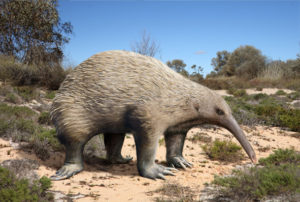Murrayglossus hacketti
Murrayglossus hacketti (formerly ‘Zaglossus‘) was a giant species of echidna that lived in Australia during the Pleistocene epoch. It could grow up to about a metre in length and weighed an estimated 30 kg, around the weight of a labrador.
Little is known of how M. hacketti lived. It has been suggested that a shortened tibia and relatively long femur helped to shift the animal’s centre of gravity backwards, increasing the mobility of the forelimbs. This could have made digging or tearing movements easier, and may have allowed an upright bipedal stance while feeding on ants or termites nests. This adaptation may also have aided in climbing trees.
The scanned bones you can view here are from the holotype specimen.
Skeletal element: Femur (left)
Specimen number: WAM 60.10.1
Significance of specimen: Holotype (part)
Geological age: Pleistocene
State/territory: Western Australia
Locality/site: Mammoth Cave, Margaret River
